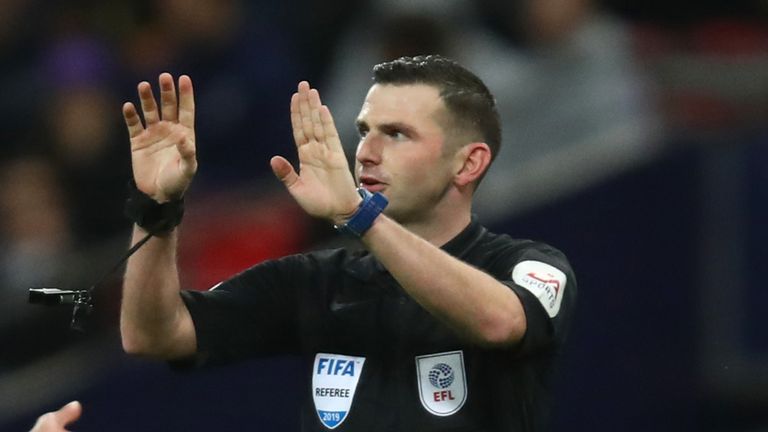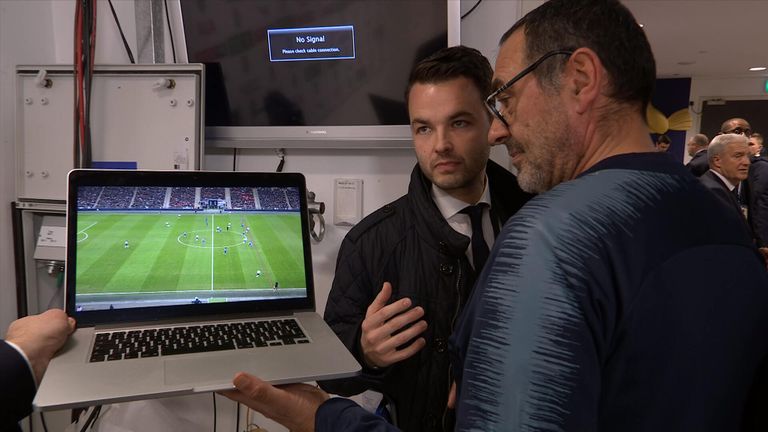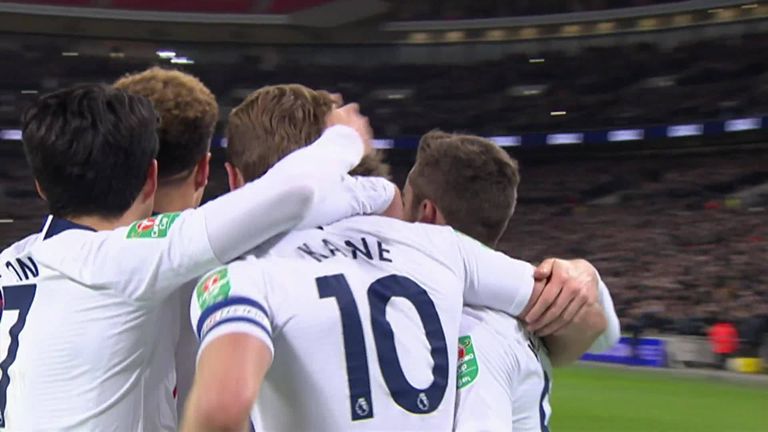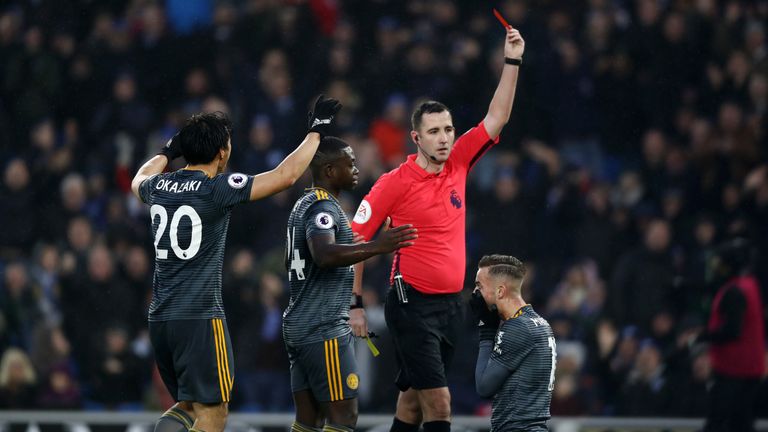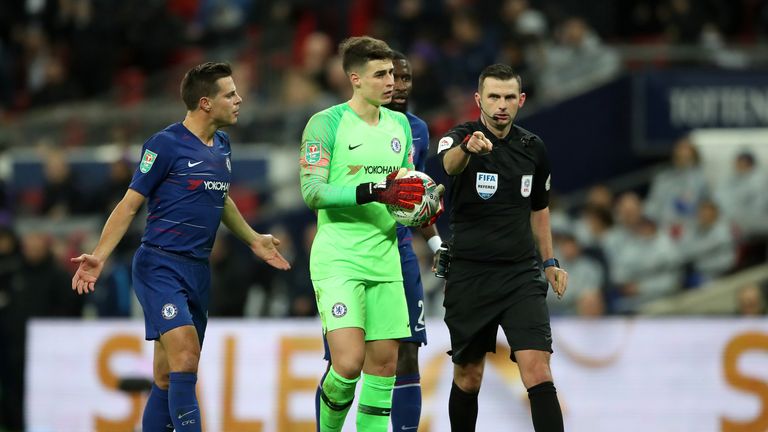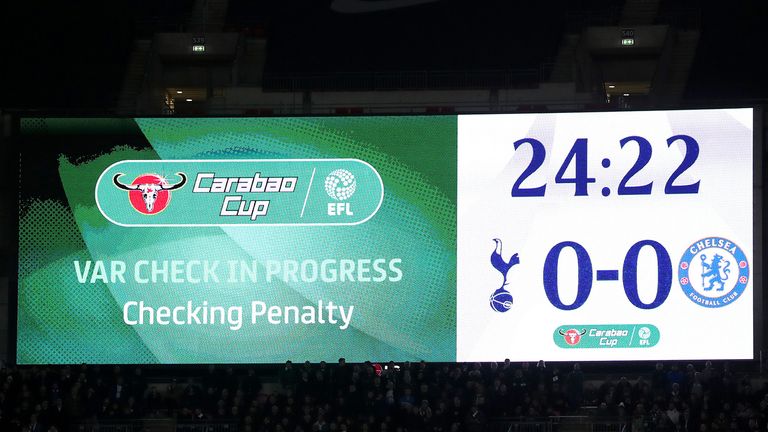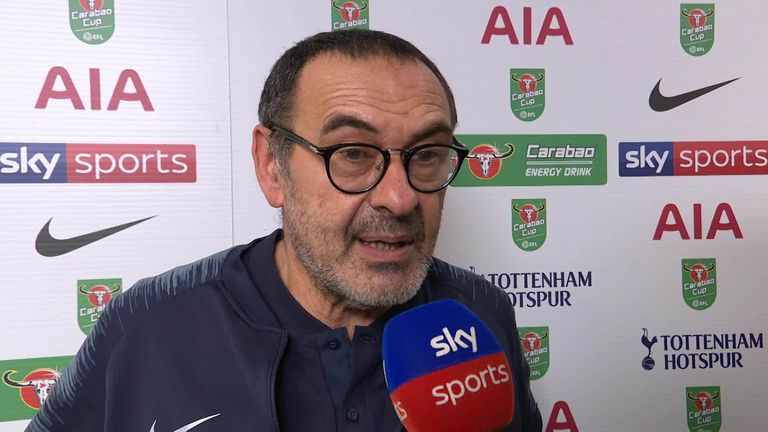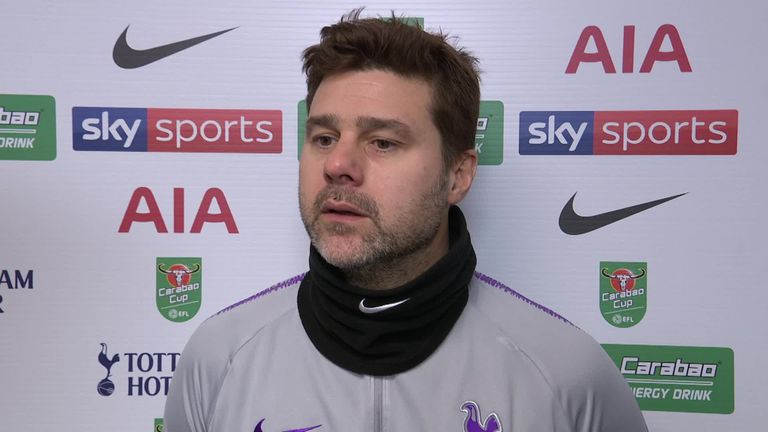VAR controversy: Key questions from Tottenham's Carabao Cup semi-final win over Chelsea
Wednesday 9 January 2019 19:42, UK
It is the decision that has got everyone talking on Wednesday.
Harry Kane may have given Tottenham a 1-0 advantage from the penalty spot in their Carabao Cup semi-final first-leg tie with Chelsea, but it is VAR controversy that was the standout moment at Wembley on Tuesday night.
Kane was deemed to be onside by the video assistant, overturning the decision by the assistant referee on the touchline, before being upended by Chelsea goalkeeper Kepa Arrizabalaga.
Chelsea, though, had a different view of the debate, with the Blues subsequently bringing out their own angle which appears to show Kane is offside.
Here, we answer all the key questions surrounding the incident...
Why did we see different angles?
HawkEye use the host broadcaster (Sky) camera angles and the goal decision system cameras to provide to the VAR for their analysis. The footage Sky showed was the one the VAR officials used to make the definitive decision.
Sky Sports News understands Chelsea had their own recording of the game from a tactical camera up in the main gantry at Wembley and used by their analyst as part of his role dissecting the contest. A line, which has not been calibrated, has been added to this to approximate an offside line.
This had a more side-on view of Kane's position than the official VAR shots and showed the Spurs striker ahead of last man Cesar Azpilicueta.
What cameras do VAR officials have access to?
Normal procedure for games played live on television allows the VAR to view all the available feeds from a host broadcaster, in this case Sky, as well as the goal-line technology cameras if they also help.
Who was the VAR official and where was he?
Chris Kavanagh was the video ref on duty on Tuesday night and the Premier League official was based in the video operations room at Stockley Park, near Heathrow airport.
What is the right procedure and was it followed correctly?
As soon as Kane was brought down, Kavanagh told referee Michael Oliver to stop play. He was looking at four angles in one monitor and decided it was a penalty within 10 seconds of choosing to review play. It was then decided that it would be a spot kick to Spurs if Kane was adjudged to be onside.
The video assistant then moved on to the offside decision. They only have the angles available via the Sky Sports cameras, with the VAR officials adding their own offside lines to the picture.
The officials then used a split screen to check whether Kane was in line at the exact time Toby Alderweireld played the ball forward. Once they had established the correct moment, it was back to the blue offside lines to check the players' positions.
Still a close decision? A highlight was added to the pictures to help try and make it clearer, before it seems the decision was made that Kane was onside, with the pictures moving on.
Ninety-three seconds after the original incident, the penalty was awarded to Spurs, with the VAR also agreeing with Michael Oliver the offence warranted a yellow card.
Oliver then showed the 'TV signal' for a reviewed decision and indicated the awarded of a spot kick.
Why did the assistant raise his flag?
At the time of the offside offence, the assistant verbally communicated to the referee that in his judgement Kane was offside. As there was a clear goalscoring opportunity though, Oliver did not stop the game at that stage.
Once Kane had been fouled, the referee then blew his whistle to stop the game. At that stage, the on-field decision was offside, as this was the first offence and the assistant correctly raised his flag to indicate the offence. The VAR could then review the offside judgement.
Why did ref not go to a monitor? Why the difference from the World Cup?
The VAR intervened in a factual decision (the offside position). In this case, the referee can rely upon the VAR's judgement. This is the same protocol that was used in the World Cup.
At this stage of the trials, the VAR can also advise the referee on more subjective decisions in order to avoid the delay that can occur when the referee goes to the monitor.
However, the referee can choose to use the monitor if that is considered appropriate.
Was the right decision made?
Yes. The offside line provided by HawkEye shows the defender's [Azpilicueta] foot is closer to the goal than Kane's body (excluding his arms, which are not considered when assessing offside position).
Here's a reminder of the relevant part of the law on offside - It states that any part of the head, body or feet should be taken into account, but the hands and arms of players are not considered.
After the match, the goalscorer highlighted an unofficial rule, but perhaps the most important one of all, when saying: "I played to the whistle. I ran through and it was a clear penalty. It was whether I was offside or not. I wasn't sure. VAR is there for a reason and I'm sure they've got it right."
Will there be any ramifications though going forward?
Neither manager was happy with how the VAR, which is set to be introduced in the Premier League next season, operated on Tuesday night.
Maurizio Sarri said Kane was clearly offside and English officials needed to study the system better.
"I saw the video from our camera a few minutes ago, it was offside," said the Chelsea head coach. "Our camera was in line with Kane, and it was offside, but it's not important.
"With the head, it's offside. But it's not important. It was important that the linesman stopped the run, he didn't follow the ball, so he had a big influence on our defenders, and at the moment I think the English referees aren't able to use the system."
Meanwhile, his Spurs counterpart, Mauricio Pochettino, was surprisingly also unhappy with events at the home of football, arguing the system is confusing and takes too long and that a lot of work is still needed to do to improve it ahead of its introduction into the Premier League next season
He told Sky Sports: "I don't like it, today we got the benefit but watching the World Cup and La Liga - no one is happy. To get the benefit is nice but I'm not happy to win the game like this.
"I prefer the technology but in a different way and to be clear in the way we use it. I am pro-technology as you can't stop the evolution. When are you going to use it? I don't think it's clear - before we use it all clubs need to agree with ideas. If not it's going to be difficult.
"We still have six months to improve the system - there's a lot of work to do."
Marc Albrighton has also called for improvements to be made to the system before its introduction in the Premier League next season.
However, the Professional Game Match Officials (PGMOL), Premier League, FA, broadcasters and clubs are all in constant discussions about the best format and how decisions will be communicated when it comes into use in the top flight next season.
Meanwhile, key testing of the VAR - which has been used in more than 25 games in the FA Cup and Carabao Cup this season so far - will also continue offline (i.e. without communication to the match officials) on 15 Saturdays using the 3pm kick-offs in Premier League games throughout the campaign.
There are test matches held regularly at St George's Park and Premier League grounds as well.

